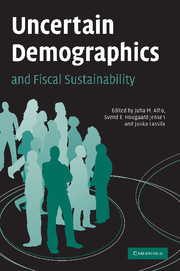Book contents
- Frontmatter
- Contents
- List of figures
- List of tables
- List of contributors
- Preface
- 1 Introduction
- Part I Uncertain demographics
- 2 Changing views of future demographic trends
- 3 Empirically based specification of forecast uncertainty
- Comment: The UPE forecasts: strengths, innovations, developments
- Part II Measuring sustainability in a stochastic environment
- Part III Enhancing sustainability
- Part IV Extensions
- Index
- References
2 - Changing views of future demographic trends
Published online by Cambridge University Press: 22 September 2009
- Frontmatter
- Contents
- List of figures
- List of tables
- List of contributors
- Preface
- 1 Introduction
- Part I Uncertain demographics
- 2 Changing views of future demographic trends
- 3 Empirically based specification of forecast uncertainty
- Comment: The UPE forecasts: strengths, innovations, developments
- Part II Measuring sustainability in a stochastic environment
- Part III Enhancing sustainability
- Part IV Extensions
- Index
- References
Summary
Introduction
Are population processes easy to predict? The relative inertia of population stocks suggests that this is the case. Indeed, errors in population forecasts five to ten years into the future are often smaller than the errors of economic forecasts over a similar period (Ascher, 1978). However, population flows are much harder to predict (Keilman, 1990), so in the long run, population processes are much more uncertain than generally recognized. Yet, many tasks of social policy, such as planning of schools and health care require information about the likely developments of population variables for twenty or thirty years into the future. Analyses of the sustainability of pension systems require that we take an even longer view, so the US Office of the Actuary routinely prepares forecasts seventy-five years into the future (Andrews and Beekman, 1987), for example.
One way the uncertainty in population variables manifests itself is through changing views, over time, of the demographic future. For instance, a forecast of a particular population made in 2000 may be different from one made ten years earlier. New data for the period 1990–2000, different interpretations of historical developments before 1990, refined techniques of analysis and prediction – all these shape different conditions for the forecast made in 2000, compared to the one made in 1990. As an example, consider Table 2.1. It shows UN forecasts of the 2050 old-age dependency ratio (OADR), i.e. the ratio of the elderly population (aged 65+) to the working age population (aged 20–64).
- Type
- Chapter
- Information
- Uncertain Demographics and Fiscal Sustainability , pp. 11 - 33Publisher: Cambridge University PressPrint publication year: 2008
References
- 7
- Cited by



